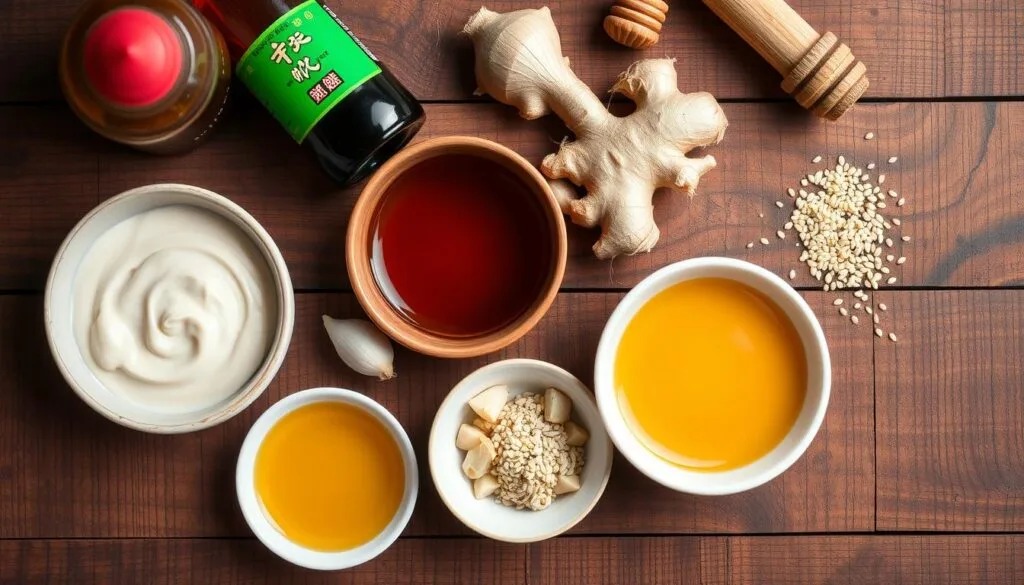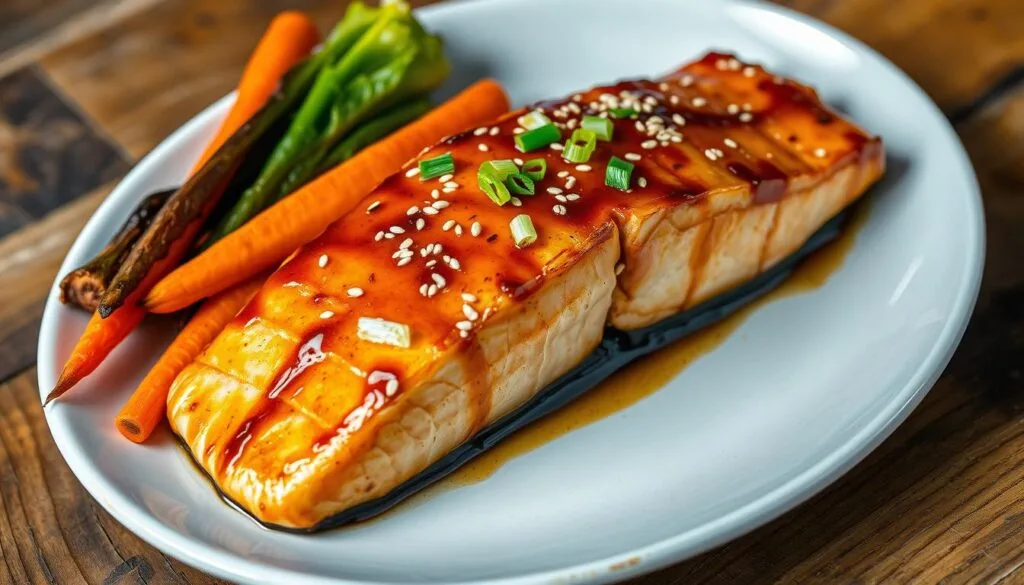“How to Make Perfect Baked Miso Salmon at Home” – A simple guide to baking salmon with a delicious m
Imagine biting into a juicy salmon fillet. The miso glaze on top is sweet and savory, perfectly cooked. The smell of miso and the sea fills your kitchen, taking you to Japan. This dish is a comfort food that you can make at home.

Miso salmon is a mix of miso’s deep flavor and salmon’s sweetness. It’s perfect for both experienced cooks and beginners. This guide will show you how to make it in your kitchen. You’ll impress everyone with a dish that tastes like it came from a restaurant.
Table of Contents
Understanding Miso Salmon: A Japanese Culinary Treasure
Miso-glazed fish, especially the umami salmon dish, is a beloved treat in Japanese cooking. It has won the hearts and taste buds of food lovers everywhere. It’s a healthy and delicious salmon dish.
The Origins of Miso-Glazed Fish
Miso-glazed fish comes from Japan’s rich culinary history. Miso, a fermented soybean paste, has been used for centuries. It adds a savory, umami flavor to many dishes.
The tradition of glazing fish with miso started in the Edo period. Chefs used it to make fresh seafood taste sweeter and more tender.
Why Miso and Salmon Make a Perfect Pair
Miso and salmon go well together. Salmon’s oiliness and buttery taste match miso’s savory and sweet flavors. The miso marinade makes the salmon tender and creates a delicious glaze.
Health Benefits of This Classic Combination
Miso salmon is not only tasty but also healthy. Salmon is full of omega-3 fatty acids, good for the heart and brain. Miso adds probiotics and vitamins, making it a nutritious choice.

“Miso salmon is a true delight for the senses, blending the rich, umami flavors of miso with the silky, omega-3-packed goodness of fresh salmon.”
Essential Ingredients for the Perfect Miso Marinade
Making a tasty miso marinade for salmon is all about picking the right ingredients. It’s about finding the perfect balance of flavors. This Japanese staple brings out the umami in your miso marinade salmon or soy-marinated salmon recipes.
Miso paste is at the heart of the marinade. It comes in different types, each with its own taste. White miso is sweet and mild, while yellow miso is more savory. Red miso adds a deep, rich flavor.
Soy sauce is also key, adding saltiness and depth. Choose low-sodium soy sauce to avoid too much salt.
Mirin, a Japanese rice wine, adds sweetness and complexity. It tenderizes the salmon and makes it shiny.
| Ingredient | Purpose |
|---|---|
| Miso paste (white, yellow, or red) | Provides the foundation of umami flavor |
| Soy sauce | Balances saltiness and depth of flavor |
| Mirin | Adds sweetness and helps tenderize the salmon |
| Garlic, ginger, and scallions (optional) | Enhances aroma and adds complexity |
Adding minced garlic, grated ginger, and sliced scallions can make your dish even better. These ingredients add depth and an authentic Japanese touch.

“The key to a perfect miso marinade is finding the right balance between the savory miso, the salty soy sauce, and the sweet mirin. Once you’ve mastered that, the possibilities for delicious miso marinade salmon and soy-marinated salmon are endless.”
By choosing and mixing these key ingredients, you can make a top-notch miso marinade salmon or soy-marinated salmon dish at home.
Selecting the Best Salmon for Your Dish
Choosing the right salmon is key to making great miso salmon. The type of salmon you pick affects the taste and texture of your dish. Let’s look at what to consider when picking the best salmon for your miso marinade.
Fresh vs. Frozen Salmon Options
Fresh and frozen salmon are both popular choices. Fresh salmon offers a luxurious taste, while frozen salmon is convenient and tasty. Frozen salmon is flash-frozen at peak freshness, keeping nutrients and flavors locked in.
When deciding between fresh and frozen, think about what you prefer and what your recipe needs.
Different Salmon Cuts and Their Uses
- Salmon Fillets: These are the most popular cut, providing meaty, evenly-sized portions that are easy to work with in miso salmon recipes.
- Salmon Steaks: Cut perpendicular to the spine, salmon steaks offer a heartier texture and are well-suited for grilling or pan-searing.
- Salmon Sides: Also known as a “salmon flank,” this long, thin cut is ideal for baking or broiling, allowing the miso marinade to fully infuse the fish.
Quality Indicators to Look For
When choosing salmon, look for certain signs of quality. Choose salmon with a vibrant color, firm flesh, and a fresh smell. Avoid salmon that looks dull, discolored, or smells strongly of fish.

Understanding the different types of salmon and knowing how to spot quality will help you pick the best salmon for your miso-glazed dish.
Kitchen Tools and Equipment You’ll Need
To make broiled miso salmon at home, you need some basic kitchen tools. Make sure you have these items ready for a great cooking experience:
- Baking sheet or shallow roasting pan: A strong, oven-safe baking sheet or roasting pan is key for baking the salmon.
- Silicone basting brush: A silicone basting brush is perfect for spreading the miso glaze evenly on the salmon fillets.
- Measuring cups and spoons: Accurate measurements of the marinade ingredients are crucial for the right miso flavor.
- Mixing bowls: You’ll need mixing bowls for making the miso marinade and marinating the salmon.
- Tongs or spatula: These are used to handle the delicate salmon fillets during cooking and plating.
If you want to broil your miso salmon, you might need a broiler pan or wire rack. This helps the marinade drip off, giving your salmon a perfect caramelized crust.
“Investing in the right kitchen tools can make all the difference in mastering the art of broiled miso salmon at home.”
Having the right equipment makes it easy to create a top-notch broiled miso salmon dish at home. Gather these essentials, and you’re on your way to a tasty and authentic Japanese-inspired meal.
Preparing Your Miso Marinade from Scratch
Making a tasty miso marinade for your salmon is easy and makes a big difference. By creating the marinade yourself, you can adjust the flavors to your liking. This brings out the fish’s natural umami.
Balancing Sweet and Savory Flavors
Getting the right mix of sweet and savory is key for a great miso marinade. Start with white or yellow miso paste and add a bit of honey or brown sugar. This balances the saltiness of the miso. Remember, the salmon will also add sweetness when it’s cooked.
Proper Mixing Techniques
- In a small bowl, whisk together the miso paste, sweetener, and a splash of water or rice vinegar until the mixture is smooth and well-incorporated.
- For added depth of flavor, consider including other aromatic ingredients such as grated ginger, minced garlic, or a sprinkle of sesame seeds.
- Continue whisking the marinade until all the components are evenly dispersed, creating a glossy, cohesive sauce.
Storage Tips for Extra Marinade
If you have leftover miso marinade, don’t throw it away. Put it in an airtight container and keep it in the fridge for up to a week. You can use it to marinate more japanese salmon recipe or as a tasty glaze for other proteins or veggies.
With these tips, you’re ready to make a miso marinade that will make your baked salmon a real treat.
Step-by-Step Marination Process
To make the perfect soy-marinated salmon or miso-glazed fish, start with a good marination. Follow these easy steps to make sure your salmon gets all the flavor it can.
- First, pick the freshest salmon fillets or steaks. Dry them with paper towels to get rid of extra moisture.
- Next, mix your homemade miso marinade, soy sauce, rice vinegar, and any other seasonings in a shallow dish or a resealable bag.
- Put the salmon pieces in the marinade, making sure they’re all coated. Cover the dish or seal the bag.
- Put the salmon in the fridge for at least 30 minutes but no more than 2 hours. This lets the flavors soak into the fish without making it tough.
- When it’s time to bake, take the salmon out of the marinade, saving any extra liquid. Dry the fillets with paper towels to help the glaze get crispy.
“The secret to a memorable miso-glazed fish dish is marinating the salmon just right. This way, the flavors blend well without overpowering the fish.”
By following these steps, you’ll get the perfect mix of savory, sweet, and umami in your soy-marinated salmon. You’ll impress everyone with your skill in this Japanese dish.
Perfect Temperature and Timing for Baked Miso Salmon
To get the perfect broiled miso salmon, you need to pay attention to oven settings and cooking times. Follow some simple steps to make sure your fish is moist, flavorful, and top-notch every time.
Optimal Oven Settings
Preheat your oven to 400°F (200°C) for the best results. This temperature is just right, letting the miso glaze caramelize while keeping the salmon tender inside. If you want a crisper outside, raise the heat to 425°F (220°C) for the last few minutes.
How to Tell When Your Salmon is Done
- Check the internal temperature with a meat thermometer. Broiled miso salmon is ready when it hits 145°F (63°C) in the thickest part.
- The salmon should flake easily with a fork and look slightly translucent in the center.
- Watch the fish closely in the last 5-10 minutes of cooking. The miso glaze can make it brown fast.
| Oven Temperature | Cooking Time | Doneness |
|---|---|---|
| 400°F (200°C) | 15-20 minutes | Moist, flaky interior with a caramelized miso glaze |
| 425°F (220°C) | 12-15 minutes | Crispy, golden-brown exterior with a juicy center |
The exact cooking time might change based on your salmon’s thickness. So, keep an eye on it as it bakes. With a bit of practice, you’ll get perfectly cooked broiled miso salmon every time.
Plating and Presentation Techniques
Make your asian-inspired seafood dish stand out by learning plating and presentation. How you arrange and garnish your umami salmon can greatly impact its look and appeal.
Choose the right serving plate or bowl first. Go for clean, modern dinnerware that matches your miso salmon’s colors and flavors. Plates with subtle patterns or textures can add interest without overpowering the fish.
- Slice the salmon into even, elegant portions, ensuring each piece is perfectly cooked and glistening.
- Arrange the salmon fillets on the plate, leaving enough negative space to allow the dish to breathe and showcase the ingredients.
- Garnish your umami salmon with fresh herbs, such as thinly sliced scallions, chives, or cilantro, to add a pop of color and freshness.
- Consider adding a drizzle of the reserved miso marinade or a light, citrusy sauce to enhance the flavors and create a visually appealing contrast.
- Finish with a sprinkle of toasted sesame seeds or a dusting of ground nori for an authentic Japanese touch.
“The way you present your asian-inspired seafood dish can make all the difference in elevating it to a restaurant-quality experience.”
Remember, the key to stunning plating and presentation is to keep it simple and let the natural beauty of the umami salmon shine. With a few thoughtful touches, you can transform your homemade miso salmon into a true culinary masterpiece.
Pairing Suggestions and Side Dishes
Enhancing your homemade japanese salmon recipe is more than just the miso glaze. The right side dishes can turn your asian-inspired seafood into a perfect meal. We’ll look at both classic Japanese pairings and new fusion ideas to go with your baked miso salmon.
Traditional Japanese Accompaniments
In Japan, miso salmon is paired with light side dishes. These dishes bring out the fish’s umami and soft texture. Here are some traditional options:
- Steamed white rice to soak up the savory sauce
- Crisp, lightly seasoned edamame for a refreshing contrast
- A simple salad of mixed greens, cucumber, and a tangy rice vinegar dressing
- Miso soup, a classic Japanese staple, to cleanse the palate
Modern Fusion Options
For a modern twist, try these side dish ideas with your japanese salmon recipe:
- Roasted sweet potato wedges with a drizzle of miso-honey glaze
- Quinoa and edamame salad with a citrus-soy dressing
- Grilled asparagus spears finished with a sprinkle of toasted sesame seeds
- Cauliflower rice stir-fried with sautéed mushrooms and scallions
When picking side dishes, aim for flavors that match your asian-inspired seafood. Mix different textures, colors, and tastes for a balanced and beautiful meal.
Troubleshooting Common Issues
Trying to make the perfect miso salmon at home can be fun. But sometimes, you might run into a few common problems. Don’t worry, we’ve got some tips to help your healthy salmon entrée come out just right every time.
One issue is the salmon drying out while baking. To stop this, keep basting the fish with the leftover miso marinade. Also, cover the dish with foil for the first half of baking. This keeps the salmon moist and prevents it from drying out.
If your miso marinade tastes too salty, you can fix it. Just add a bit of water or low-sodium broth to it. The goal is to get a mix of sweet, savory, and salty that goes well with the fish. Play with the amounts of miso, sugar, and other ingredients until you get it just right.
FAQ
What is miso salmon?
Miso salmon is a tasty dish from Japan. It’s made by marinating salmon in a sweet and savory miso sauce. Then, it’s baked or broiled until it’s perfectly cooked. This method makes the salmon’s outside crispy and the inside juicy.
What are the key ingredients in a miso salmon marinade?
A good miso salmon marinade has miso paste, soy sauce, and mirin. You also need brown sugar and sometimes ginger or garlic. These ingredients mix to create a flavor that’s both sweet and savory.
What type of salmon is best for miso salmon?
Choose fresh, high-quality salmon for the best miso salmon. Sockeye or king salmon works well because of their rich flavor. Make sure the salmon isn’t frozen before, as it can be drier.
How long should I marinate the salmon in the miso mixture?
Marinate the salmon for 30 minutes to 1 hour. This lets the flavors soak into the fish without making it too soft. Let it marinate for at least 30 minutes before cooking.
What’s the best way to cook miso salmon?
Cook miso salmon in the oven at 400°F (200°C). Bake or broil it for 12-15 minutes, until it’s flaky. Baste it with the marinade for a caramelized glaze.
How can I tell when the miso salmon is done?
The salmon is ready when it’s 145°F (63°C) inside and flakes easily. It should also have a shiny glaze. Don’t overcook it, as it can get dry.
What are some good side dishes to serve with miso salmon?
Serve miso salmon with steamed rice, miso soup, or a simple salad. For a twist, try it with roasted veggies, quinoa, or a cucumber salad.
How can I reheat leftover miso salmon?
Reheat it in the oven at 350°F (175°C) for 5-7 minutes. This keeps it moist and the glaze intact. Avoid the microwave to prevent drying out.

